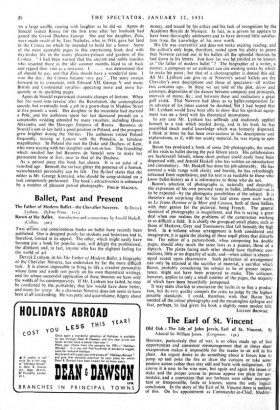Ballet, Past and Present
Baron at The Ballet. Introduction and commentary by Arnold Haskell. (Collins. 305.)
Two saio-us and conscientious books on ballet have recently been published. One is designed purely for students and historians and is, therefore, limited in its appeal. The other, which might easily have become just a book for popular taste, will delight the professional, the dilettanti and, in fact, anyone who has the slightest feeling for the world of art
Deryck Lynham. in his The Father of Modern Ballet, a biography of the Chevalier Noverre, has undertaken by far the more difficult task. It is almost impossible to bring to life a creative personality whose fame and worth rest purely on his own theoretical writings, and for whose.successful application of these theories we have only the wads of his contemporaries. If Mr. Lynham has failed, he may be comforted by the probability that few would have done better, and many far worse As a character Noverre does not seem to have been at all outsfanaing. He was petty and quarrelsome, fidgety about money, and teased by his critics and his lack of recognition by the Academic Royale de Musique. In fact, as a person he appears to have been thoroughly adolescent and to have derived little satisfac- tion from the knowledge of his own worth.
His life was uneventful and does not make exciting reading, and the author's only hope, therefore, rested upon his ability to prove that Noverre carried out in his ballets all the splendid theories he laid down in his letters. Just how far was he-entitled to be known as "the father of modern ballet " ? The biographer of a writer, a painter, a composer or an architect can cite existing works by which to make his point ; but that of a choreographer is denied this aid. All Mr. Lynham can give us of Noverre's actual ballets are the Chevalier's own descriptions and those of spectators—all written two centuries ago. In these we are told of the plot, decor and costumes, disposition of the dances between company and principals, intervals of mime, &c.; and between these and realisation a great gulf exists. That Noverre had ideas as to bfllet-composition far in advance of his times cannot be doubted, Tut I had hoped that Mr. Lynham would have been able to show that his spiritual equip- ment was on a level with his theoretical innovations.
In any case Mr. Lynham has selflessly and studiously applied himself to a task which needed doing, and in his book he has assembled much useful knowledge which was formerly dispersed. I think at times he has been over-zealous in his descriptions and explanations, as if, with too scanty material, he was trying to spin it out.
Baron has produced a book of some 280 photographs, the result of his visits to ballet during the past fifteen years. His collaborators are Sacheverell Sitwell, whose short preface could easily have been dispensed with, and Arnold Haskell who has written an introduction and commentary. Mr. Haskell has done his job admirably. He has covered a wide range with clarity and brevity, he has refreshingly refrained from superlatives, and his text is as readable to those who know ballet-history as it is informative to those who do not.
Baron's selection of photographs is, naturally and desirably. the expression of his own personal taste in ballet, influenced—as is to be expected—by the photogenic possibilities of the subject. It is therefore not surprising that he has laid stress upon such works as Le Jenne Homme et la Mort and Carmen, both of these ballets, with their genius for the pictorial, being French. The general standard of photography is magnificent, and this is saying a great deal when one realises the problems of the cameraman working in so difficult a field. It is chiefly the groups of, small plates, such as those of Markova, Grey and Toumanova that fall beneath the high level. In z' volume whose arrangement is both considered and imaginative, it is again the placing of these silvan plates that disturbs me. The editor of a picture-book. when composing his double pages, should obey much the same laws as a painter, those of a diptych. The plates facing each other should have rhythmic con- nections, little or no disparity of scale, and—when colour is absent— equal accent upon chiaroscuro. Such perfection of arrangement can only be attained at the sacrifice of material, a sacrifice which Baron, probably considering his subject to be of greater impor- tance, might not have been prepared to make. This criticism. however, applies to only a small number of the pages, the majority of which have -been beautifully juxtaposed.
It may scan churlish to enumerate the faults in so fine a produc- tion, but its very quality compels the critic to ,judge by the highest possible standards. I could, therefore, wish that Baron had omitted all the colour photography and the meaningless epilogue and that, perhaps, he had given his book a slightly more modest title.
LILLIAN BROWSE.


































 Previous page
Previous page